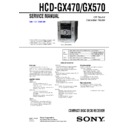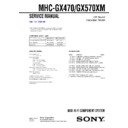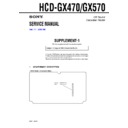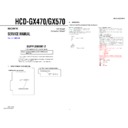Read Sony HCD-GX470 / HCD-GX570 / MHC-GX470 / MHC-GX570XM Service Manual online
SERVICE MANUAL
COMPACT DISC DECK RECEIVER
US Model
Canadian Model
Ver. 1.3 2008.09
SPECIFICATIONS
9-887-123-04
2008I05-1
© 2008.09
© 2008.09
Sony Corporation
Audio&Video Business Group
Published by Sony Techno Create Corporation
Published by Sony Techno Create Corporation
Photo: HCD-GX470
•
HCD-GX470 is the amplifier, CD player, tape
deck and tuner section in MHC-GX470.
deck and tuner section in MHC-GX470.
•
HCD-GX570 is the amplifier, CD player, tape
deck and tuner section in MHC-GX570.
deck and tuner section in MHC-GX570.
Main unit
AUDIO POWER SPECIFICATIONS
POWER OUTPUT AND TOTAL HARMONIC
DISTORTION: (The United States model only)
With 6 ohm loads, both channels driven, from
120
POWER OUTPUT AND TOTAL HARMONIC
DISTORTION: (The United States model only)
With 6 ohm loads, both channels driven, from
120
−
10,000 Hz; rated 125 watts per channel
minimum RMS power, with no more than 10%
total harmonic distortion from 250 milliwatts to
rated output.
total harmonic distortion from 250 milliwatts to
rated output.
Amplifier section
GX470
GX570
Front speaker
Continuous RMS power output
(reference): 125 + 125 watts (6 ohms at
1 kHz, 10% THD)
Total harmonic distortion: less than 0.07%
(6 ohms at 1 kHz, 80 W)
(reference): 125 + 125 watts (6 ohms at
1 kHz, 10% THD)
Total harmonic distortion: less than 0.07%
(6 ohms at 1 kHz, 80 W)
Subwoofer
Continuous RMS power output
(reference): 150 watts (6 ohms at 80 Hz,
10% THD)
Total harmonic distortion: less than 0.07%
(6 ohms at 80 Hz, 90 W)
(reference): 150 watts (6 ohms at 80 Hz,
10% THD)
Total harmonic distortion: less than 0.07%
(6 ohms at 80 Hz, 90 W)
Front speaker:
Continuous RMS power output (reference):
145 + 145 W (6 ohms at 1 kHz, 10% THD)
Total harmonic distortion: less than 0.07%
(6 ohms at 1 kHz, 80 W)
145 + 145 W (6 ohms at 1 kHz, 10% THD)
Total harmonic distortion: less than 0.07%
(6 ohms at 1 kHz, 80 W)
Subwoofer:
Continuous RMS power output (reference):
170 W (6 ohms at 80 Hz, 10% THD)
Total harmonic distortion: less than 0.07%
(6 ohms at 80 Hz, 90 W)
170 W (6 ohms at 80 Hz, 10% THD)
Total harmonic distortion: less than 0.07%
(6 ohms at 80 Hz, 90 W)
Inputs
AUDIO IN (stereo mini jack): voltage 250 mV,
impedance 47 kilohms
impedance 47 kilohms
Outputs
PHONES (stereo mini jack):
accepts headphones of 8 ohms or more
SPEAKER: accepts impedance of 6 to 16 ohms
SUBWOOFER OUT:
accepts impedance of 6 to 16 ohms
accepts headphones of 8 ohms or more
SPEAKER: accepts impedance of 6 to 16 ohms
SUBWOOFER OUT:
accepts impedance of 6 to 16 ohms
Inputs:
AUDIO IN (stereo mini jack): voltage
250 mV, impedance 47 kilohms
250 mV, impedance 47 kilohms
Outputs:
PHONES (stereo mini jack): accepts
headphones of 8 ohms or more
SPEAKER: accepts impedance of 6 to
16 ohms
SUBWOOFER OUT: accepts
impedance of 6 to 16 ohms
headphones of 8 ohms or more
SPEAKER: accepts impedance of 6 to
16 ohms
SUBWOOFER OUT: accepts
impedance of 6 to 16 ohms
CD player section
System: Compact disc and digital audio system
Laser Diode Properties
Laser Diode Properties
Emission duration: continuous
Laser Output*: Less than 44.6
Laser Output*: Less than 44.6
µ
W
*This output is the value measurement at a
distance of 200mm from the objective lens
surface on the Optical Pick-up Block with 7mm
aperture.
surface on the Optical Pick-up Block with 7mm
aperture.
Frequency response: 20 Hz
−
20 kHz
Signal-to-noise ratio: More than 90 dB
Dynamic range: More than 90 dB
Dynamic range: More than 90 dB
Tape deck section
Recording system: 4-track 2-channel, stereo
Frequency response: 50
Frequency response: 50
−
13,000 Hz (
±
3 dB),
using Sony TYPE I cassettes
– Continued on next page –
Model Name Using Similar Mechanism
HCD-GX555
CD
CD Mechanism Type
CDM74KF-K6BD83S
Section
Base Unit Name
BU-K6BD83S-WOD
Optical Pick-up Block Name
KSM-213DCP
TAPE
Model Name Using Similar Mechanism
NEW
Section
Tape Transport Mechanism Type
CWN42FF609
HCD-GX470/GX570
2
HCD-GX470/GX570
Notes on chip component replacement
•
Never reuse a disconnected chip component.
•
Notice that the minus side of a tantalum capacitor may be
damaged by heat.
Flexible Circuit Board Repairing
•
Keep the temperature of the soldering iron around 270 ˚C
during repairing.
•
Do not touch the soldering iron on the same conductor of the
circuit board (within 3 times).
•
Be careful not to apply force on the conductor when soldering
or unsoldering.
General
Power requirements
AC 120 V, 60 Hz
Power consumption
USA model:
GX470: 240 watts
GX570: 270 watts
GX470: 240 watts
GX570: 270 watts
GX470: Approx. 280
×
328
×
412.3 mm
GX570: Approx. 280
×
348
×
412.3 mm
Canadian model:
GX470: 320 VA
GX570: 360 VA
GX470: 320 VA
GX570: 360 VA
Dimensions (w/h/d) (excl. speakers):
Mass (excl. speakers): Approx. 9.4 kg
Design and specifications are subject to change
without notice.
without notice.
Tuner section
FM stereo, FM/AM superheterodyne tuner
FM tuner section:
Tuning range
87.5
87.5
−
108.0 MHz (100 kHz step)
Antenna: FM lead antenna
Antenna terminals: 75 ohms unbalanced
Intermediate frequency: 10.7 MHz
Antenna terminals: 75 ohms unbalanced
Intermediate frequency: 10.7 MHz
AM tuner section:
Tuning range
530
530
−
1,710 kHz (with 10 kHz tuning interval)
531
−
1,710 kHz (with 9 kHz tuning interval)
Antenna: AM loop antenna, external antenna
terminal
Intermediate frequency: 450 kHz
terminal
Intermediate frequency: 450 kHz
ATTENTION AU COMPOSANT AYANT RAPPORT
À LA SÉCURITÉ!
LES COMPOSANTS IDENTIFIÉS PAR UNE MARQUE
0
SUR
LES DIAGRAMMES SCHÉMATIQUES ET LA LISTE DES
PIÈCES SONT CRITIQUES POUR LA SÉCURITÉ DE
FONCTIONNEMENT. NE REMPLACER CES COM- POSANTS
QUE PAR DES PIÈCES SONY DONT LES NUMÉROS SONT
DONNÉS DANS CE MANUEL OU DANS LES SUPPLÉMENTS
PUBLIÉS PAR SONY.
PIÈCES SONT CRITIQUES POUR LA SÉCURITÉ DE
FONCTIONNEMENT. NE REMPLACER CES COM- POSANTS
QUE PAR DES PIÈCES SONY DONT LES NUMÉROS SONT
DONNÉS DANS CE MANUEL OU DANS LES SUPPLÉMENTS
PUBLIÉS PAR SONY.
SAFETY-RELATED COMPONENT WARNING!!
COMPONENTS IDENTIFIED BY MARK
0
OR DOTTED LINE
WITH MARK
0
ON THE SCHEMATIC DIAGRAMS AND IN
THE PARTS LIST ARE CRITICAL TO SAFE OPERATION.
REPLACE THESE COMPONENTS WITH SONY PARTS WHOSE
PART NUMBERS APPEAR AS SHOWN IN THIS MANUAL OR
IN SUPPLEMENTS PUBLISHED BY SONY.
REPLACE THESE COMPONENTS WITH SONY PARTS WHOSE
PART NUMBERS APPEAR AS SHOWN IN THIS MANUAL OR
IN SUPPLEMENTS PUBLISHED BY SONY.
SAFETY CHECK-OUT
After correcting the original service problem, perform the following
safety check before releasing the set to the customer:
Check the antenna terminals, metal trim, “metallized” knobs, screws,
and all other exposed metal parts for AC leakage.
Check leakage as described below.
safety check before releasing the set to the customer:
Check the antenna terminals, metal trim, “metallized” knobs, screws,
and all other exposed metal parts for AC leakage.
Check leakage as described below.
LEAKAGE TEST
The AC leakage from any exposed metal part to earth ground and
from all exposed metal parts to any exposed metal part having a
return to chassis, must not exceed 0.5 mA (500 microamperes.).
Leakage current can be measured by any one of three methods.
from all exposed metal parts to any exposed metal part having a
return to chassis, must not exceed 0.5 mA (500 microamperes.).
Leakage current can be measured by any one of three methods.
1. A commercial leakage tester, such as the Simpson 229 or RCA
WT-540A. Follow the manufacturers’ instructions to use these
instruments.
instruments.
2. A battery-operated AC milliammeter. The Data Precision 245
digital multimeter is suitable for this job.
3. Measuring the voltage drop across a resistor by means of a
VOM or battery-operated AC voltmeter. The “limit” indication
is 0.75 V, so analog meters must have an accurate low-voltage
scale. The Simpson 250 and Sanwa SH-63Trd are examples
of a passive VOM that is suitable. Nearly all battery operated
digital multimeters that have a 2 V AC range are suitable. (See
Fig. A)
is 0.75 V, so analog meters must have an accurate low-voltage
scale. The Simpson 250 and Sanwa SH-63Trd are examples
of a passive VOM that is suitable. Nearly all battery operated
digital multimeters that have a 2 V AC range are suitable. (See
Fig. A)
Fig. A.
Using an AC voltmeter to check AC leakage.
1.5 k
Ω
0.15
µ
F
AC
voltmeter
(0.75 V)
voltmeter
(0.75 V)
To Exposed Metal
Parts on Set
Parts on Set
Earth Ground
3
HCD-GX470/GX570
TABLE OF CONTENTS
1.
SERVICING NOTES
...............................................
4
2.
GENERAL
...................................................................
5
3.
DISASSEMBLY
3-1.
Disassembly Flow ...........................................................
9
3-2.
Case (Side-L), Case (Side-R) .......................................... 10
3-3.
Case (Top) ....................................................................... 10
3-4.
Lid (CD) .......................................................................... 11
3-5
CD Mechanism Deck (CDM74KF-K6BD83S) .............. 11
3-6.
Front Panel Block ............................................................ 12
3-7.
Mecha Deck (CWN42FF609) ......................................... 12
3-8.
Back Panel Section .......................................................... 13
3-9.
MAIN Board .................................................................... 13
3-10. CD Board ......................................................................... 14
3-11. DRIVE Board, SW Board ............................................... 14
3-12. Optical Pick-up Block ..................................................... 15
3-13. SENSOR Board ............................................................... 15
3-14. MOTOR (TB) Board ....................................................... 16
3-15. MOTOR (LD) Board ....................................................... 16
3-11. DRIVE Board, SW Board ............................................... 14
3-12. Optical Pick-up Block ..................................................... 15
3-13. SENSOR Board ............................................................... 15
3-14. MOTOR (TB) Board ....................................................... 16
3-15. MOTOR (LD) Board ....................................................... 16
4.
TEST MODE
.............................................................. 17
5.
MECHANICAL ADJUSTMENTS
....................... 20
6.
ELECTRICAL ADJUSTMENTS
......................... 21
7.
DIAGRAMS
7-1.
Block Diagram – CD SERVO Section – ......................... 23
7-2.
Block Diagram – MAIN Section – .................................. 24
7-3.
Block Diagram – AMP Section – .................................... 25
7-4.
Block Diagram
– PANEL, POWER SUPPLY Section – .......................... 26
– PANEL, POWER SUPPLY Section – .......................... 26
7-5.
Printed Wiring Board – CD Board – ............................... 28
7-6.
Schematic Diagram – CD Board – .................................. 29
7-7.
Printed Wiring Boards – CHANGER Section – .............. 30
7-8.
Schematic Diagram – CHANGER Section – .................. 31
7-9.
Printed Wiring Board – DECK Board – .......................... 32
7-10. Schematic Diagram – DECK Board – ............................. 33
7-11. Printed Wiring Board – MAIN Board – .......................... 34
7-12. Schematic Diagram – MAIN Board (1/3) – .................... 35
7-13. Schematic Diagram – MAIN Board (2/3) – .................... 36
7-14. Schematic Diagram – MAIN Board (3/3) – .................... 37
7-15. Printed Wiring Board – XM Board (GX570) – ............... 38
7-16. Schematic Diagram – XM Board (GX570) – .................. 39
7-17. Printed Wiring Board – MIC. AUX. HP Board – ............ 40
7-18. Schematic Diagram – MIC. AUX. HP Board – ............... 41
7-19. Printed Wiring Board – POWER Board – ....................... 42
7-20. Schematic Diagram – POWER Board – .......................... 43
7-21. Printed Wiring Boards – SUB WOOFER Section – ........ 44
7-22. Schematic Diagram – SUB WOOFER Section – ............ 45
7-23. Printed Wiring Board – PANEL Board – ........................ 46
7-24. Printed Wiring Boards – KEY Section – ......................... 47
7-25. Schematic Diagram – PANEL Section – ......................... 48
7-26. Printed Wiring Board – TRANSFORMER Board – ....... 49
7-27. Schematic Diagram – TRANSFORMER Board – .......... 50
7-11. Printed Wiring Board – MAIN Board – .......................... 34
7-12. Schematic Diagram – MAIN Board (1/3) – .................... 35
7-13. Schematic Diagram – MAIN Board (2/3) – .................... 36
7-14. Schematic Diagram – MAIN Board (3/3) – .................... 37
7-15. Printed Wiring Board – XM Board (GX570) – ............... 38
7-16. Schematic Diagram – XM Board (GX570) – .................. 39
7-17. Printed Wiring Board – MIC. AUX. HP Board – ............ 40
7-18. Schematic Diagram – MIC. AUX. HP Board – ............... 41
7-19. Printed Wiring Board – POWER Board – ....................... 42
7-20. Schematic Diagram – POWER Board – .......................... 43
7-21. Printed Wiring Boards – SUB WOOFER Section – ........ 44
7-22. Schematic Diagram – SUB WOOFER Section – ............ 45
7-23. Printed Wiring Board – PANEL Board – ........................ 46
7-24. Printed Wiring Boards – KEY Section – ......................... 47
7-25. Schematic Diagram – PANEL Section – ......................... 48
7-26. Printed Wiring Board – TRANSFORMER Board – ....... 49
7-27. Schematic Diagram – TRANSFORMER Board – .......... 50
8.
EXPLODED VIEWS
8-1.
Case Section .................................................................... 63
8-2.
PANEL Board Section ..................................................... 64
8-3.
Lid (Top) Section ............................................................. 65
8-4.
Front Panel Section ......................................................... 66
8-5.
MAIN Board Section ....................................................... 67
8-6.
POWER Board, SUB WOOFER Board Section ............. 68
8-7.
Chassis Section ................................................................ 69
8-8.
CD Mechanism Deck Section-1
(CDM74KF-K6BD83S) .................................................. 70
(CDM74KF-K6BD83S) .................................................. 70
8-9.
CD Mechanism Deck Section-2
(CDM74KF-K6BD83S) .................................................. 71
(CDM74KF-K6BD83S) .................................................. 71
9.
ELECTRICAL PARTS LIST
................................ 72
4
HCD-GX470/GX570
SECTION 1
SERVICING NOTES
NOTES ON HANDLING THE OPTICAL PICK-UP
BLOCK OR BASE UNIT
BLOCK OR BASE UNIT
The laser diode in the optical pick-up block may suffer electrostatic
break-down because of the potential difference generated by the
charged electrostatic load, etc. on clothing and the human body.
During repair, pay attention to electrostatic break-down and also
use the procedure in the printed matter which is included in the
repair parts.
The flexible board is easily damaged and should be handled with
care.
break-down because of the potential difference generated by the
charged electrostatic load, etc. on clothing and the human body.
During repair, pay attention to electrostatic break-down and also
use the procedure in the printed matter which is included in the
repair parts.
The flexible board is easily damaged and should be handled with
care.
NOTES ON LASER DIODE EMISSION CHECK
The laser beam on this model is concentrated so as to be focused on
the disc reflective surface by the objective lens in the optical pick-
up block. Therefore, when checking the laser diode emission,
observe from more than 30 cm away from the objective lens.
the disc reflective surface by the objective lens in the optical pick-
up block. Therefore, when checking the laser diode emission,
observe from more than 30 cm away from the objective lens.
UNLEADED SOLDER
Boards requiring use of unleaded solder are printed with the lead-
free mark (LF) indicating the solder contains no lead.
(Caution: Some printed circuit boards may not come printed with
free mark (LF) indicating the solder contains no lead.
(Caution: Some printed circuit boards may not come printed with
the lead free mark due to their particular size)
: LEAD FREE MARK
Unleaded solder has the following characteristics.
•
Unleaded solder melts at a temperature about 40
°
C higher
than ordinary solder.
Ordinary soldering irons can be used but the iron tip has to be
applied to the solder joint for a slightly longer time.
Soldering irons using a temperature regulator should be set to
about 350
°
C.
Caution: The printed pattern (copper foil) may peel away if
the heated tip is applied for too long, so be careful!
•
Strong viscosity
Unleaded solder is more viscou-s (sticky, less prone to flow)
Unleaded solder is more viscou-s (sticky, less prone to flow)
than ordinary solder so use caution not to let solder bridges
occur such as on IC pins, etc.
occur such as on IC pins, etc.
•
Usable with ordinary solder
It is best to use only unleaded solder but unleaded solder may
It is best to use only unleaded solder but unleaded solder may
also be added to ordinary solder.
RELEASING THE ANTITHEFT LOCK
The disc table lock function for the antitheft of an demonstration
disc in the store is equipped.
disc in the store is equipped.
Releasing Procedure :
1. Press the
I
/1
button to turn the power on.
2. While pressing the
s
button, press the
A
button until
“UNLOCKED” displayed on the fluorescent indicator tube
(around 5 seconds).
(around 5 seconds).
Note:
When “LOCKED” is displayed, the antitheft lock is not released by
turning power on/off with the
turning power on/off with the
I/
1
button.
MODEL IDENTIFICATION
– Back Panel –
– Back Panel –
Label indication
Model
2-664-530-0[]
GX570: US
2-664-531-0[]
GX570: Canadian
2-664-532-0[]
GX470: US
2-664-533-0[]
GX470: Canadian
Model number label




